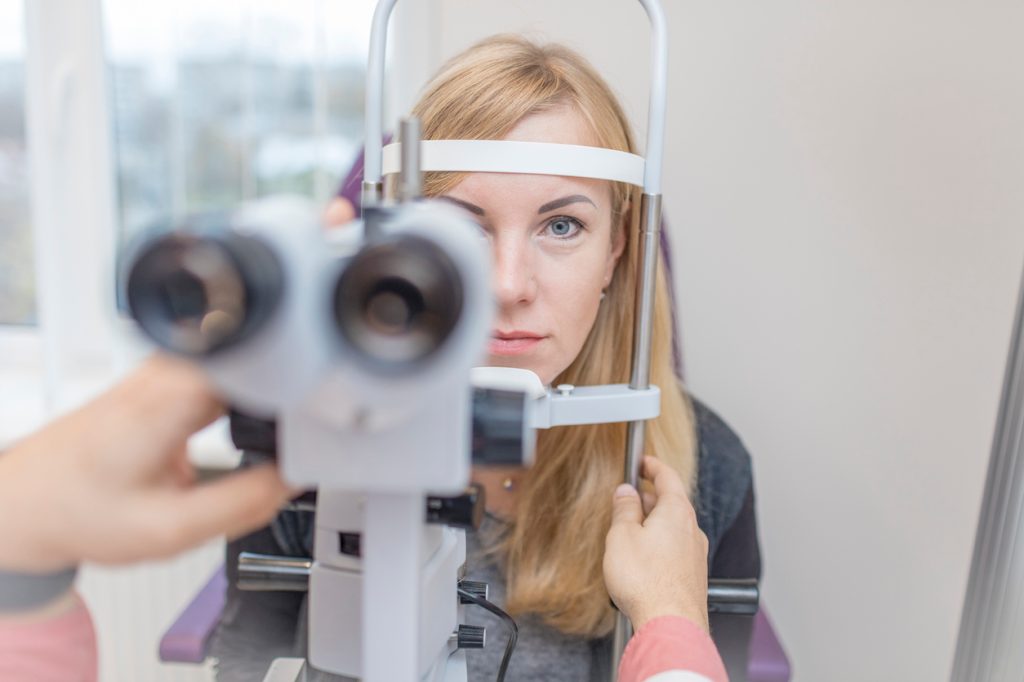Four Ways Your Eyes May Be Telling You Your Brain Is in Trouble
While the eyes are known for being expressive—think “puppy dog eyes” or “sparkling with happiness”—they can also reveal a lot about what’s going on with our health. Not only do our eyes enable us to see approximately 200 degrees in all directions and distinguish millions of colors, but thanks to their direct link to our brains, they can provide important clues to our cognitive functioning.
“Over 70 percent of your brain is involved with vision, and 80 percent of all sensory information goes through your eyes, so your eyes and retinal health intrinsically hold clues for neurological function,” says Robert Layman, MD, a practicing optometrist and president of the American Optometric Association (AOA). “In many neurological diseases, the eyes are often the first site to manifest a disorder.”
Read on to find out what symptoms to watch for—and when it’s time to give your doctor a call.
READ THIS NEXT: Maria Menounos Says This Was the First Symptom of Her Brain Tumor.

Blurry vision is caused by a number of different issues, and many of them are easily addressed. Maybe you need a new eyeglasses prescription, or your desk is right by an air conditioner that blows air into your eyes all day, drying them out. But other reasons for blurry vision are far more serious. “Blurred vision can result from many causes, including uncorrected refractive errors, binocular vision dysfunction, ocular and systemic diseases, and sight- or life-threatening conditions such as tumors of the brain,” warns Layman.
Another serious potential cause for blurry vision is multiple sclerosis (MS). “The disease causes inflammation along the nerve that connects your eyes to your brain, called the optic nerve,” according to WebMD. “That causes a condition called optic neuritis, which can give you blurry sight, loss of color vision, and pain when you move your eyes.” This can often occur in only one eye, and may be accompanied by other symptoms such as fatigue, dizziness, and feeling stiff or weak.

It’s a cartoon cliché that when you hit your head, you see stars. But in real life, as well, visual symptoms are a common sign of a brain injury. “Ninety percent of patients with traumatic brain injuries, such as a concussion, will suffer visual symptoms,” Layman explains. “Symptoms are not always noticeable, but can include double vision, poor eye tracking ability, difficulty with shifting gaze quickly from one point to another, blurred near vision, glare or light sensitivity, and eye strain.”
Layman says it’s important to get checked out by a medical professional when you sustain any type of head trauma, no matter how minor it may seem. “Even mild brain injuries can have a drastic impact on your vision, and only a trained eye care specialist can thoroughly diagnose and treat vision impairments,” he explains.

“The eyes contain elements of the peripheral nervous system, with eye movement based on the firing and wiring of cranial nerves,” says Layman. “So they contain a great deal of information in regard to systemic and neurological health.” In other words, your eyes can tell you a lot about the health of your whole body—including your brain.
When loss of vision occurs, it can signal a problem like a detached retina, according to the Moffitt Cancer Center—but it could also be a symptom of a brain tumor: “If a brain tumor exerts enough pressure on the optic nerve, blindness can occur,” their experts say. “For many patients, the loss of vision is gradual, beginning with blurry vision, double vision or an increasing blind spot. As the tumor grows, however, it will compress the optic nerve, resulting in greater vision loss.”
RELATED:
For more up-to-date information, sign up for our
daily newsletter.

When we see something out of the corner of our eye, we are utilizing our peripheral vision. And certain vision changes, including decreased peripheral vision, may be a sign of Alzheimer’s disease.
“Many individuals with Alzheimer’s disease may have a critical vision impairment where there may be nothing physically wrong with their eyes, but the brain is not fully processing visual information,” Kendra Farrow, Research and Training Associate with the National Research and Training Center (NRTC) at Mississippi State University, told the Alzheimer’s Foundation of America (AFA). “The brain cannot interpret what is being seen,” she explains. Farrow describes this condition as being similar to “looking through a tube” and being unable to see not just things that are on the side of your vision, but also on the top or bottom.
If you experience changes in your peripheral vision or other changes in your eyesight that cause concern, make an appointment to speak with your doctor as soon as possible.
READ THIS NEXT: The “Crazy” Way Mark Ruffalo Discovered He Had a Brain Tumor.
" Conservative News Daily does not always share or support the views and opinions expressed here; they are just those of the writer."

Now loading...